A Comprehensive Analysis of Impairment Loss for CGUs & Goodwill
VerifiedAdded on 2023/06/11
|6
|1256
|114
Essay
AI Summary
This essay provides a detailed analysis of impairment loss for cash generating units (CGUs) including goodwill, adhering to AASB 136 guidelines. It explains the purpose and objectives of impairment testing, emphasizing its role in ensuring the true and fair value of assets and enhancing transparency in financial reporting. The essay covers the computation of impairment loss, the allocation of goodwill, and the treatment of recoverable amounts. It highlights that impairment loss is first deducted from goodwill and then from cash generating units, excluding inventory. The discussion includes formulas for calculating impairment loss and emphasizes the importance of regular impairment tests to maintain accurate asset valuations and build stakeholder trust. The essay concludes by stressing the need for companies to adhere to IAS 136 standards for proper impairment loss management.
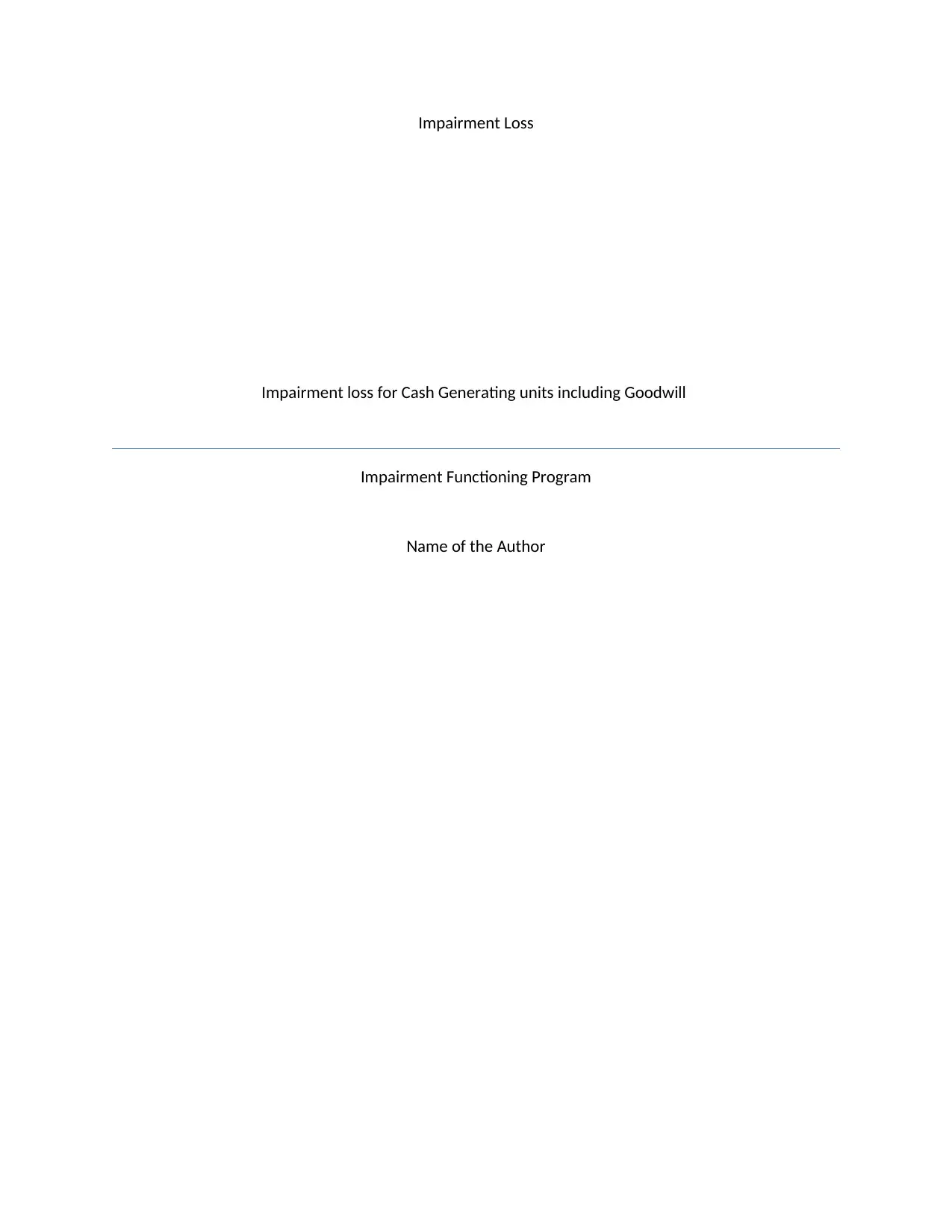
Impairment Loss
Impairment loss for Cash Generating units including Goodwill
Impairment Functioning Program
Name of the Author
Impairment loss for Cash Generating units including Goodwill
Impairment Functioning Program
Name of the Author
Paraphrase This Document
Need a fresh take? Get an instant paraphrase of this document with our AI Paraphraser
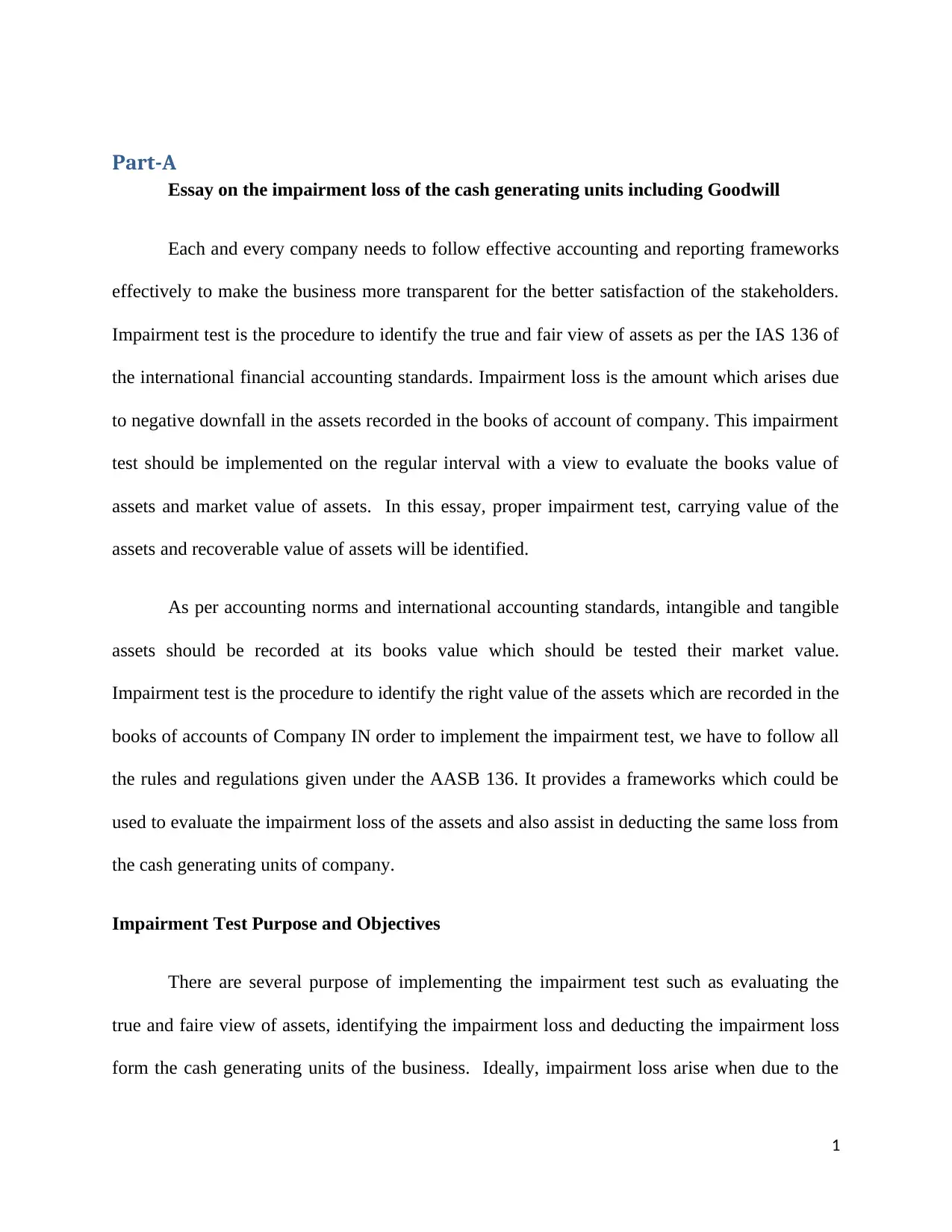
Part-A
Essay on the impairment loss of the cash generating units including Goodwill
Each and every company needs to follow effective accounting and reporting frameworks
effectively to make the business more transparent for the better satisfaction of the stakeholders.
Impairment test is the procedure to identify the true and fair view of assets as per the IAS 136 of
the international financial accounting standards. Impairment loss is the amount which arises due
to negative downfall in the assets recorded in the books of account of company. This impairment
test should be implemented on the regular interval with a view to evaluate the books value of
assets and market value of assets. In this essay, proper impairment test, carrying value of the
assets and recoverable value of assets will be identified.
As per accounting norms and international accounting standards, intangible and tangible
assets should be recorded at its books value which should be tested their market value.
Impairment test is the procedure to identify the right value of the assets which are recorded in the
books of accounts of Company IN order to implement the impairment test, we have to follow all
the rules and regulations given under the AASB 136. It provides a frameworks which could be
used to evaluate the impairment loss of the assets and also assist in deducting the same loss from
the cash generating units of company.
Impairment Test Purpose and Objectives
There are several purpose of implementing the impairment test such as evaluating the
true and faire view of assets, identifying the impairment loss and deducting the impairment loss
form the cash generating units of the business. Ideally, impairment loss arise when due to the
1
Essay on the impairment loss of the cash generating units including Goodwill
Each and every company needs to follow effective accounting and reporting frameworks
effectively to make the business more transparent for the better satisfaction of the stakeholders.
Impairment test is the procedure to identify the true and fair view of assets as per the IAS 136 of
the international financial accounting standards. Impairment loss is the amount which arises due
to negative downfall in the assets recorded in the books of account of company. This impairment
test should be implemented on the regular interval with a view to evaluate the books value of
assets and market value of assets. In this essay, proper impairment test, carrying value of the
assets and recoverable value of assets will be identified.
As per accounting norms and international accounting standards, intangible and tangible
assets should be recorded at its books value which should be tested their market value.
Impairment test is the procedure to identify the right value of the assets which are recorded in the
books of accounts of Company IN order to implement the impairment test, we have to follow all
the rules and regulations given under the AASB 136. It provides a frameworks which could be
used to evaluate the impairment loss of the assets and also assist in deducting the same loss from
the cash generating units of company.
Impairment Test Purpose and Objectives
There are several purpose of implementing the impairment test such as evaluating the
true and faire view of assets, identifying the impairment loss and deducting the impairment loss
form the cash generating units of the business. Ideally, impairment loss arise when due to the
1
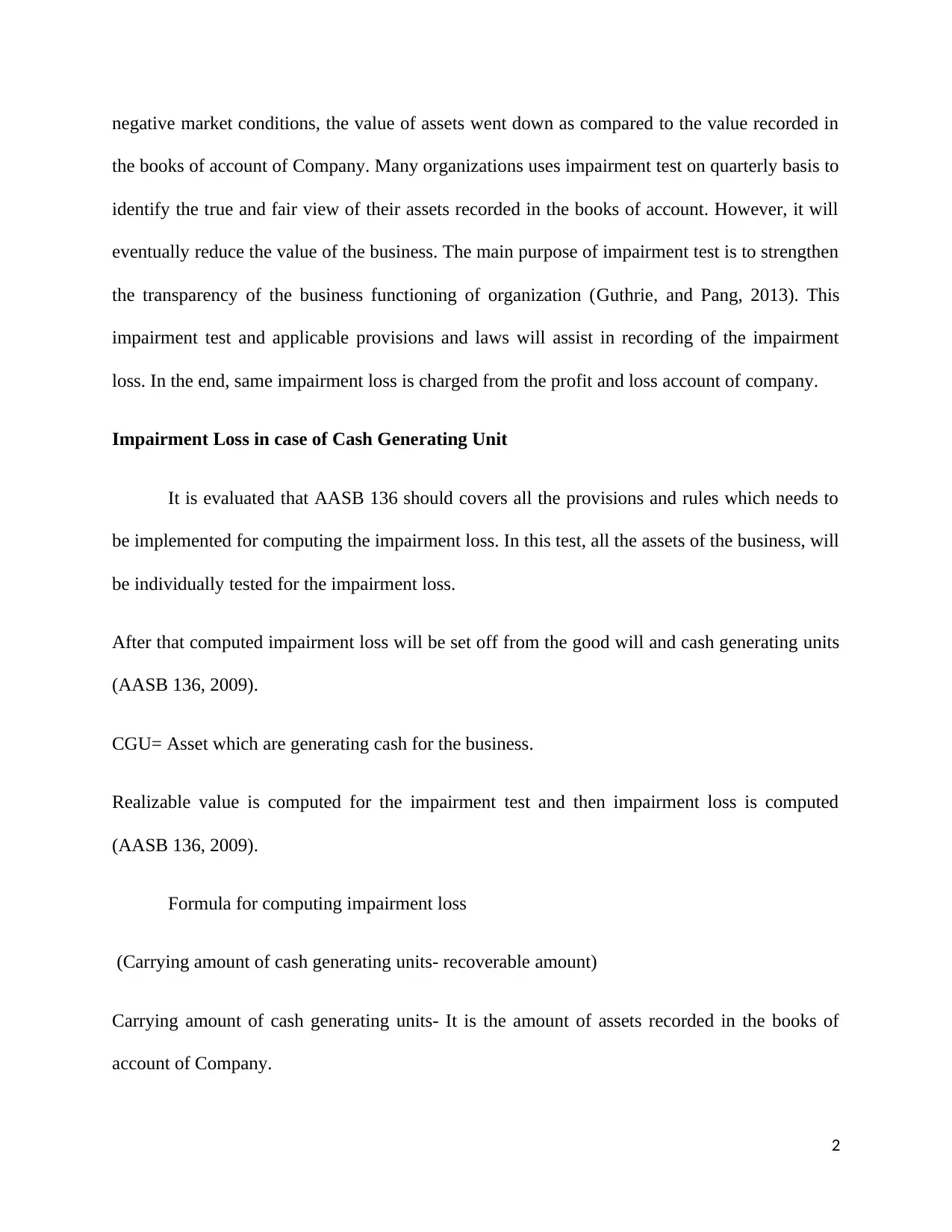
negative market conditions, the value of assets went down as compared to the value recorded in
the books of account of Company. Many organizations uses impairment test on quarterly basis to
identify the true and fair view of their assets recorded in the books of account. However, it will
eventually reduce the value of the business. The main purpose of impairment test is to strengthen
the transparency of the business functioning of organization (Guthrie, and Pang, 2013). This
impairment test and applicable provisions and laws will assist in recording of the impairment
loss. In the end, same impairment loss is charged from the profit and loss account of company.
Impairment Loss in case of Cash Generating Unit
It is evaluated that AASB 136 should covers all the provisions and rules which needs to
be implemented for computing the impairment loss. In this test, all the assets of the business, will
be individually tested for the impairment loss.
After that computed impairment loss will be set off from the good will and cash generating units
(AASB 136, 2009).
CGU= Asset which are generating cash for the business.
Realizable value is computed for the impairment test and then impairment loss is computed
(AASB 136, 2009).
Formula for computing impairment loss
(Carrying amount of cash generating units- recoverable amount)
Carrying amount of cash generating units- It is the amount of assets recorded in the books of
account of Company.
2
the books of account of Company. Many organizations uses impairment test on quarterly basis to
identify the true and fair view of their assets recorded in the books of account. However, it will
eventually reduce the value of the business. The main purpose of impairment test is to strengthen
the transparency of the business functioning of organization (Guthrie, and Pang, 2013). This
impairment test and applicable provisions and laws will assist in recording of the impairment
loss. In the end, same impairment loss is charged from the profit and loss account of company.
Impairment Loss in case of Cash Generating Unit
It is evaluated that AASB 136 should covers all the provisions and rules which needs to
be implemented for computing the impairment loss. In this test, all the assets of the business, will
be individually tested for the impairment loss.
After that computed impairment loss will be set off from the good will and cash generating units
(AASB 136, 2009).
CGU= Asset which are generating cash for the business.
Realizable value is computed for the impairment test and then impairment loss is computed
(AASB 136, 2009).
Formula for computing impairment loss
(Carrying amount of cash generating units- recoverable amount)
Carrying amount of cash generating units- It is the amount of assets recorded in the books of
account of Company.
2
⊘ This is a preview!⊘
Do you want full access?
Subscribe today to unlock all pages.

Trusted by 1+ million students worldwide
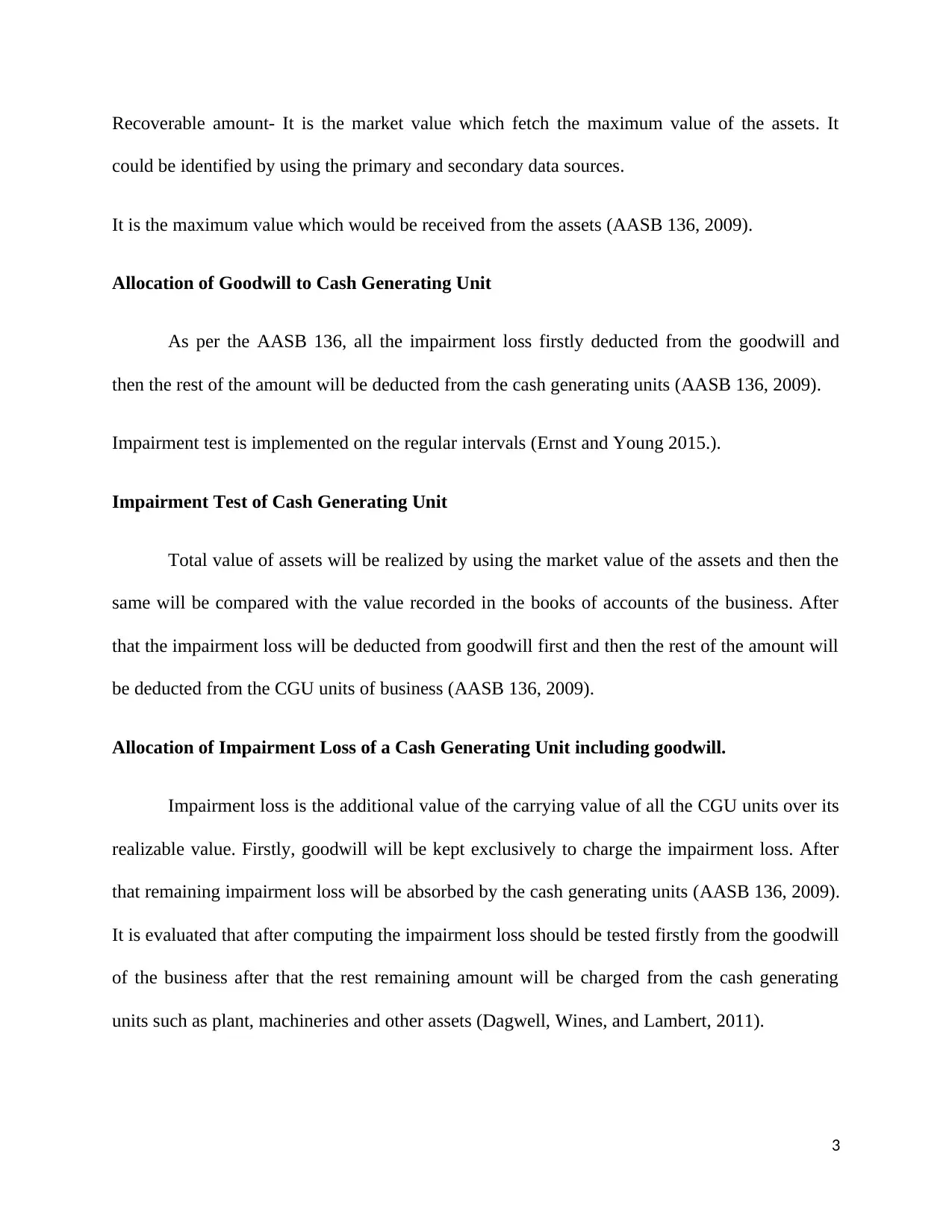
Recoverable amount- It is the market value which fetch the maximum value of the assets. It
could be identified by using the primary and secondary data sources.
It is the maximum value which would be received from the assets (AASB 136, 2009).
Allocation of Goodwill to Cash Generating Unit
As per the AASB 136, all the impairment loss firstly deducted from the goodwill and
then the rest of the amount will be deducted from the cash generating units (AASB 136, 2009).
Impairment test is implemented on the regular intervals (Ernst and Young 2015.).
Impairment Test of Cash Generating Unit
Total value of assets will be realized by using the market value of the assets and then the
same will be compared with the value recorded in the books of accounts of the business. After
that the impairment loss will be deducted from goodwill first and then the rest of the amount will
be deducted from the CGU units of business (AASB 136, 2009).
Allocation of Impairment Loss of a Cash Generating Unit including goodwill.
Impairment loss is the additional value of the carrying value of all the CGU units over its
realizable value. Firstly, goodwill will be kept exclusively to charge the impairment loss. After
that remaining impairment loss will be absorbed by the cash generating units (AASB 136, 2009).
It is evaluated that after computing the impairment loss should be tested firstly from the goodwill
of the business after that the rest remaining amount will be charged from the cash generating
units such as plant, machineries and other assets (Dagwell, Wines, and Lambert, 2011).
3
could be identified by using the primary and secondary data sources.
It is the maximum value which would be received from the assets (AASB 136, 2009).
Allocation of Goodwill to Cash Generating Unit
As per the AASB 136, all the impairment loss firstly deducted from the goodwill and
then the rest of the amount will be deducted from the cash generating units (AASB 136, 2009).
Impairment test is implemented on the regular intervals (Ernst and Young 2015.).
Impairment Test of Cash Generating Unit
Total value of assets will be realized by using the market value of the assets and then the
same will be compared with the value recorded in the books of accounts of the business. After
that the impairment loss will be deducted from goodwill first and then the rest of the amount will
be deducted from the CGU units of business (AASB 136, 2009).
Allocation of Impairment Loss of a Cash Generating Unit including goodwill.
Impairment loss is the additional value of the carrying value of all the CGU units over its
realizable value. Firstly, goodwill will be kept exclusively to charge the impairment loss. After
that remaining impairment loss will be absorbed by the cash generating units (AASB 136, 2009).
It is evaluated that after computing the impairment loss should be tested firstly from the goodwill
of the business after that the rest remaining amount will be charged from the cash generating
units such as plant, machineries and other assets (Dagwell, Wines, and Lambert, 2011).
3
Paraphrase This Document
Need a fresh take? Get an instant paraphrase of this document with our AI Paraphraser
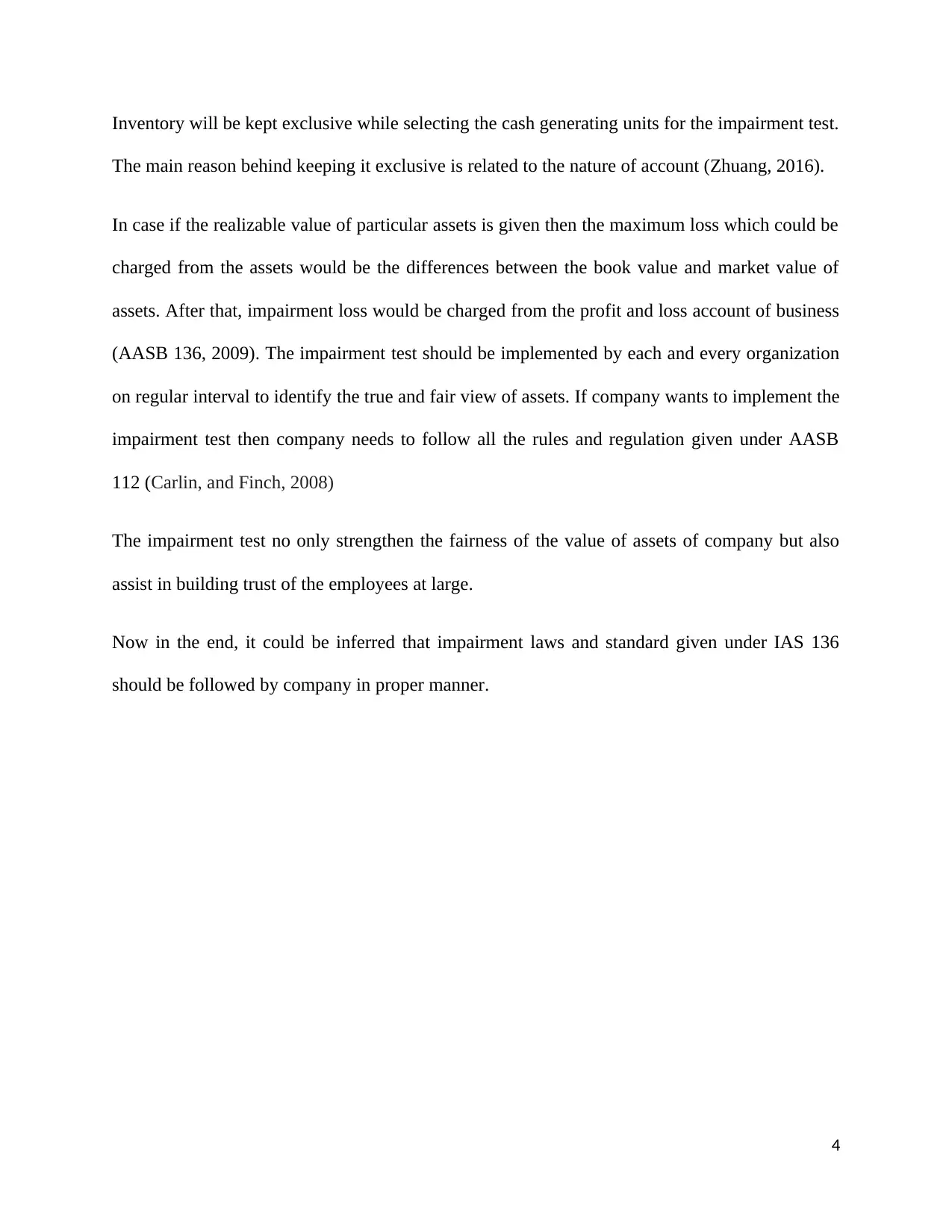
Inventory will be kept exclusive while selecting the cash generating units for the impairment test.
The main reason behind keeping it exclusive is related to the nature of account (Zhuang, 2016).
In case if the realizable value of particular assets is given then the maximum loss which could be
charged from the assets would be the differences between the book value and market value of
assets. After that, impairment loss would be charged from the profit and loss account of business
(AASB 136, 2009). The impairment test should be implemented by each and every organization
on regular interval to identify the true and fair view of assets. If company wants to implement the
impairment test then company needs to follow all the rules and regulation given under AASB
112 (Carlin, and Finch, 2008)
The impairment test no only strengthen the fairness of the value of assets of company but also
assist in building trust of the employees at large.
Now in the end, it could be inferred that impairment laws and standard given under IAS 136
should be followed by company in proper manner.
4
The main reason behind keeping it exclusive is related to the nature of account (Zhuang, 2016).
In case if the realizable value of particular assets is given then the maximum loss which could be
charged from the assets would be the differences between the book value and market value of
assets. After that, impairment loss would be charged from the profit and loss account of business
(AASB 136, 2009). The impairment test should be implemented by each and every organization
on regular interval to identify the true and fair view of assets. If company wants to implement the
impairment test then company needs to follow all the rules and regulation given under AASB
112 (Carlin, and Finch, 2008)
The impairment test no only strengthen the fairness of the value of assets of company but also
assist in building trust of the employees at large.
Now in the end, it could be inferred that impairment laws and standard given under IAS 136
should be followed by company in proper manner.
4
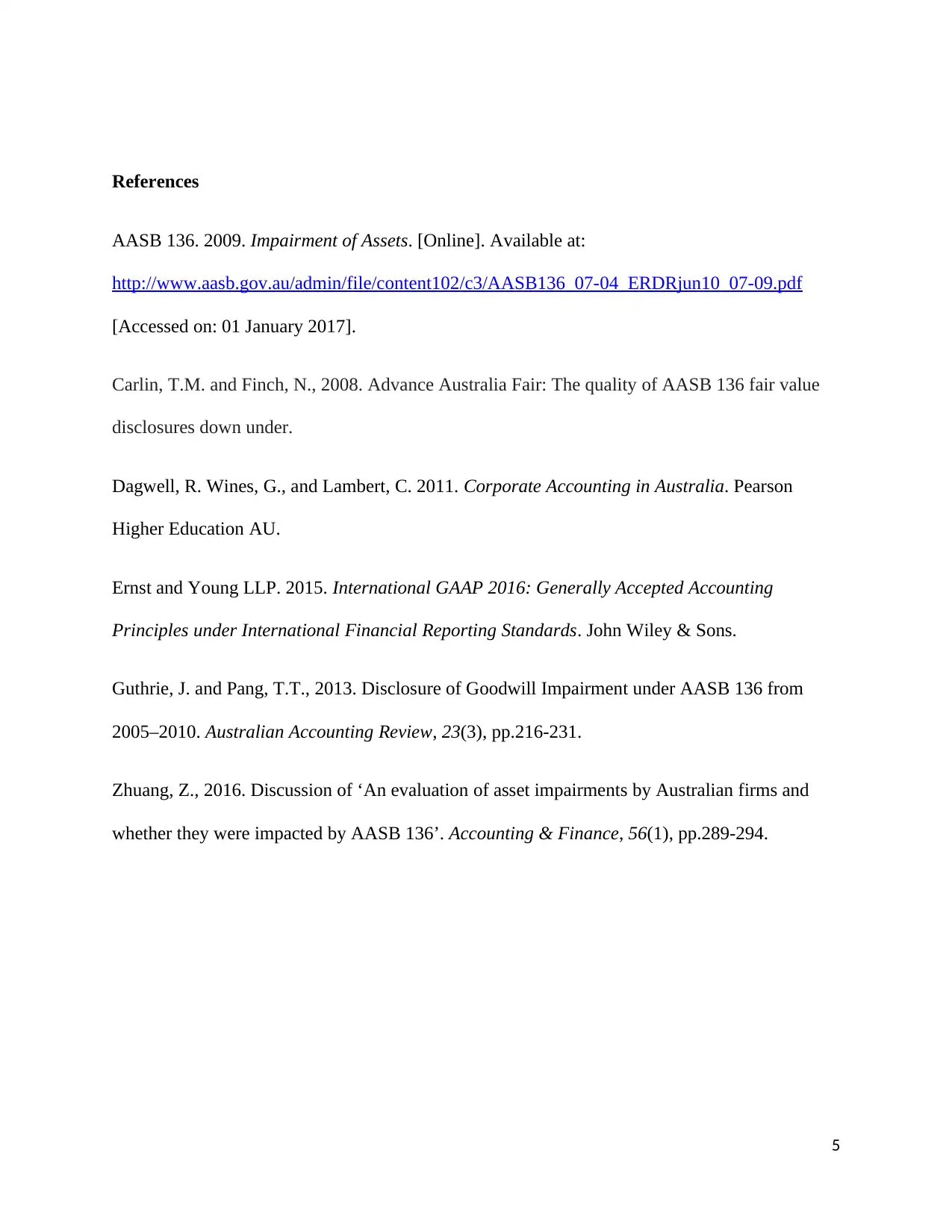
References
AASB 136. 2009. Impairment of Assets. [Online]. Available at:
http://www.aasb.gov.au/admin/file/content102/c3/AASB136_07-04_ERDRjun10_07-09.pdf
[Accessed on: 01 January 2017].
Carlin, T.M. and Finch, N., 2008. Advance Australia Fair: The quality of AASB 136 fair value
disclosures down under.
Dagwell, R. Wines, G., and Lambert, C. 2011. Corporate Accounting in Australia. Pearson
Higher Education AU.
Ernst and Young LLP. 2015. International GAAP 2016: Generally Accepted Accounting
Principles under International Financial Reporting Standards. John Wiley & Sons.
Guthrie, J. and Pang, T.T., 2013. Disclosure of Goodwill Impairment under AASB 136 from
2005–2010. Australian Accounting Review, 23(3), pp.216-231.
Zhuang, Z., 2016. Discussion of ‘An evaluation of asset impairments by Australian firms and
whether they were impacted by AASB 136’. Accounting & Finance, 56(1), pp.289-294.
5
AASB 136. 2009. Impairment of Assets. [Online]. Available at:
http://www.aasb.gov.au/admin/file/content102/c3/AASB136_07-04_ERDRjun10_07-09.pdf
[Accessed on: 01 January 2017].
Carlin, T.M. and Finch, N., 2008. Advance Australia Fair: The quality of AASB 136 fair value
disclosures down under.
Dagwell, R. Wines, G., and Lambert, C. 2011. Corporate Accounting in Australia. Pearson
Higher Education AU.
Ernst and Young LLP. 2015. International GAAP 2016: Generally Accepted Accounting
Principles under International Financial Reporting Standards. John Wiley & Sons.
Guthrie, J. and Pang, T.T., 2013. Disclosure of Goodwill Impairment under AASB 136 from
2005–2010. Australian Accounting Review, 23(3), pp.216-231.
Zhuang, Z., 2016. Discussion of ‘An evaluation of asset impairments by Australian firms and
whether they were impacted by AASB 136’. Accounting & Finance, 56(1), pp.289-294.
5
⊘ This is a preview!⊘
Do you want full access?
Subscribe today to unlock all pages.

Trusted by 1+ million students worldwide
1 out of 6
Related Documents
Your All-in-One AI-Powered Toolkit for Academic Success.
+13062052269
info@desklib.com
Available 24*7 on WhatsApp / Email
![[object Object]](/_next/static/media/star-bottom.7253800d.svg)
Unlock your academic potential
Copyright © 2020–2025 A2Z Services. All Rights Reserved. Developed and managed by ZUCOL.




